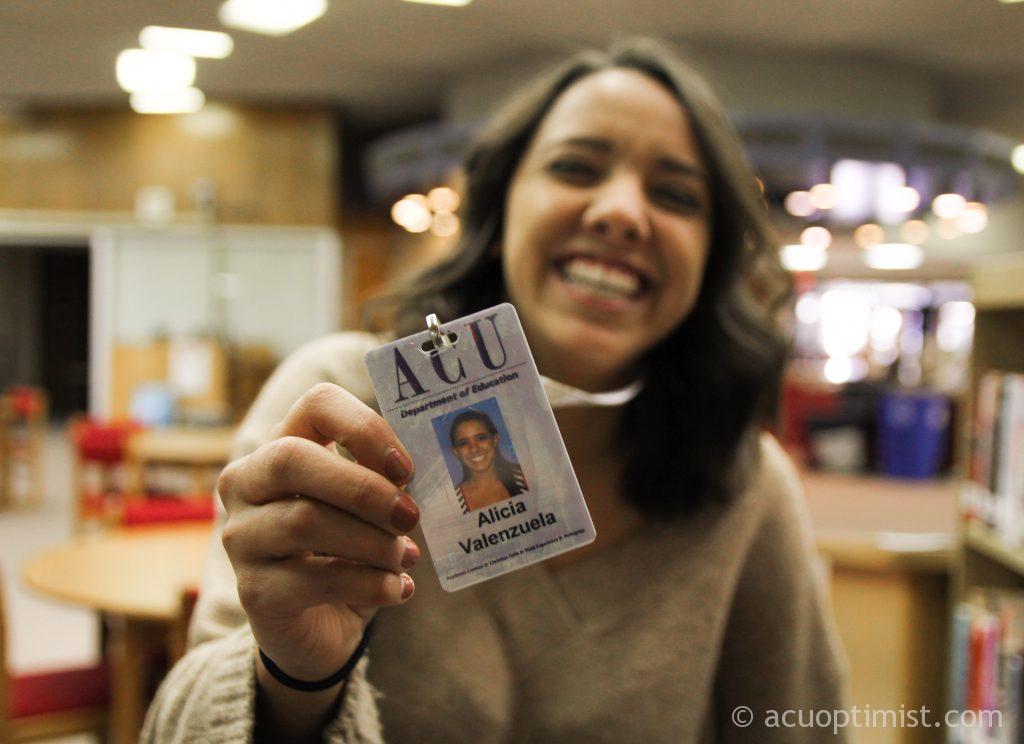For many ACU students on the cusp of adulthood, teaching a classroom of high school students about thesis statements and outlines remains as terrifying as it is unlikely. But, for Sarai Valenzuela, wrangling a herd of high school students is a daily occurrence.
Just three years after she graduated high school, Valenzuela, a senior English for teaching major from El Paso, is now teaching a classroom of students at Cooper High School. She grades papers, creates lesson plans and instructs the students every day. At the end of her semester of student teaching, she’ll graduate from ACU and start teaching on her own.
“I worry sometimes that this will be the rest of my life,” Valenzuela said, grinning and pointing at the stack of papers awaiting grading.

Valenzuela helps students in her student teaching class.
But right now, she leans on the doorway to the classroom and smiles at the unruly collection of high schoolers tumbling through the door. She teaches AP English III, the last class of the day for this group of 11th graders. The classroom hums with the energy unique to teenagers.
Once they’re all seated, she leans over the lectern and looks at her class, bantering with the talkative teenagers. Colorful, hand-crafted posters dot the walls, accentuating the classroom’s welcoming vibe. Although Valenzuela is only a few years older than her students, she’s in control. She may be new, but she’s also prepared.
Valenzuela was well prepared by ACU’s Department of Teacher Education. The clinical teaching experience at ACU is a two-semester process. The first semester of a student’s senior year is spent shadowing. The student shadows a local teacher, completes administrative work, grades papers and observes classroom dynamics.
Although the semester of shadowing can be dull, it’s intended to be a foundational experience, grounding students in the high school classroom environment.
Mitzi Adams, the clinical teaching coordinator in the teacher education department, said students will gradually take on more tasks throughout the semester until they are responsible for everything at the end.
Lily Auker, a senior English major from San Angelo, is among a group of students shadowing at Abilene High this semester. She admitted that it can be dull at times, but that she really enjoys the experience.
“This semester is just about watching and learning,” Auker said. “It’s about pedagogical learning, before we start teaching for real next semester.”
The semester of shadowing is also a chance for students to acquire hands-on teaching skills from the high school teachers.
“Now I’m not learning the content from you [the teacher], I’m learning what you’re doing right and what I’ve been taught is right and wrong,” said Crysta Cook, a senior history teaching major shadowing at Abilene High this semester.
Because this clinical teaching program is crucial to the development of future teachers, Adams in the teacher education department helps mold each student’s experience to produce the optimum results.
Healthy, robust feedback is the cornerstone of the clinical teaching experience. The clinical teacher is assigned a clinical supervisor who is a professor in the department. The student regularly meets with the clinical supervisor and Adams to process specific challenges with students in the classroom. Additionally, the student is assigned a cooperating teacher who supervises them in the classroom and assists them throughout the semester. These three supervisors constitute a sounding board for the clinical teacher to pose ideas and questions. Adams calls it the “triad of supervision.”
“Our candidates get eight observations in a semester with pretty robust feedback,” Adams said. “That prepares them to be successful.”
The emphasis on feedback in college is often lamented by students. It can be awkward and embarrassing. But Adams emphasized the importance of feedback, asserting that a rigorous program and the extensive support system set ACU’s students up for success in the workplace.
“The profession of teaching is incredibly complex, it is a difficult job,” Adams said. “When our clinical teachers go out to teach, it is not unusual for us to hear back from them in their first year that they had their first observation and their principal said that they are performing like a second or third year teacher already. We hold them to a very high standard.”
Crysta Cook appreciated the way the teacher education department taught innovative teaching techniques so that clinical teachers could learn to engage their future students in a more robust way.
“I think that’s something I really love about this department, they are teaching us new and innovative ways to engage kids,” Cook said. “So instead of just reading a paragraph or writing a book, there’s activities where you can use your phone, relating to them.”
Back in Sarai Valenzuela’s classroom, it’s research paper day. Long sighs and groans echo around the classroom when the assignment is announced by Jenny Oglesby, Valenzuela’s supervising teacher.
“Save yourself the heartache and learn it now,” Valenzuela says. “It’s not going away.”
Soon, the class moves to a computer lab and Oglesby steps out, leaving Valenzuela alone and in control.
“They’re pretty fun, they really are,” Oglesby whispers to me, pointing at the class of high schoolers all listening to Valenzuela explain another assignment. She may be worried about grading papers for the rest of her life, but right now she’s captivated a room of unruly high schoolers and is absorbed in the moment.

